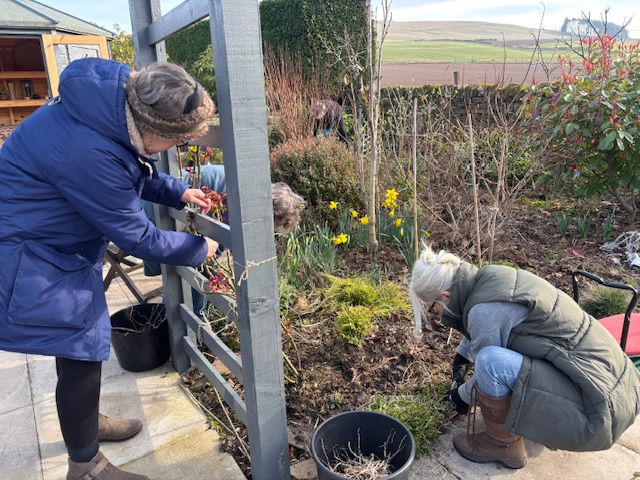'CUT OUT AND KEEP', GARDENING STRETCHES
- Susie Black

- 11 hours ago
- 4 min read
How does your email inbox look at the moment? I have to confess, mine is pristine. A cluttered email inbox would keep me awake at night so I'm ruthless with my pruning.
The downside of this is that even if I receive a very helpful newsletter from a sales or advice agency, I have it binned in seconds, never to to be found again. I suppose the same goes for those of you who have 1538+ emails in your inbox awaiting your attention, it's no easier to manage.
All of which leads me to this blog series - CUT OUT AND KEEP! I'll be posting activity-based pdfs for you to save or print off if the subject interests you. As soon as you see a subject that chimes, just save or print the doc and you'll have a go-to exercise program cluttering up your paper to-do pile AND your computer desktop AND your email inbox.
Today, it's stretches for gardeners. Thanks to class member Daz B-L for the gardening photo of her community garden group hard at work in March!

The Gardener’s Guide to Stretching: Keeping Your Body Limber in the Garden
Gardening is a joyful and rewarding activity, but anyone who has spent an afternoon tending to plants knows that it can also be physically demanding. Whether you’re kneeling to weed, reaching to prune, or carrying heavy bags of soil, gardening engages multiple muscle groups and can lead to stiffness, soreness, or even injury if proper precautions aren’t taken. One of the best ways to safeguard your body and enhance your gardening experience is through stretching.
Why Stretching Matters
As we age, our muscles and joints naturally lose some of their flexibility, making them more prone to injury. Gardening often involves repetitive motions and sustained postures that can put strain on the body. Stretching before and after gardening helps to:
Increase flexibility and range of motion
Improve circulation and reduce stiffness
Prevent injuries by loosening tight muscles
Reduce post-gardening aches and pains
Enhance overall mobility and endurance
Below are ten effective stretches tailored specifically for gardeners. Performing these before and after your gardening session can keep your body feeling strong and comfortable. CLICK HERE for the pdf
10 Essential Stretches for Gardeners
1. Standing Side Stretch
Why? Reaching and twisting while pruning or harvesting can strain your sides and lower back.
How: Stand tall with feet hip-width apart. Raise one arm overhead and gently lean to the opposite side, feeling the stretch along your side. Hold for 15–30 seconds and switch sides.
2. Shoulder Rolls
Why? Carrying tools and reaching overhead can tighten the shoulders and neck.
How: Stand or sit up straight. Slowly roll your shoulders forward in a circular motion for 10 seconds, then roll them backward for another 10 seconds. Repeat 3–5 times.
3. Seated Forward Fold
Why? Kneeling and bending over plants can tighten the lower back and hamstrings.
How: Sit on a chair with your feet flat on the floor. Slowly lean forward, reaching toward your toes while keeping your back straight. Hold for 15–30 seconds and return to an upright position.
4. Wrist and Finger Stretch
Why? Digging, pruning, and holding tools can cause wrist and hand stiffness.
How: Extend one arm forward with your palm facing up. Use the opposite hand to gently pull back your fingers, stretching the wrist. Hold for 15 seconds, then switch sides. Repeat with the palm facing downward.
5. Quad Stretch
Why? Squatting and kneeling put strain on the quadriceps (thigh muscles).
How: Stand tall and hold onto a sturdy surface for balance. Bend one knee, bringing your foot toward your glutes, and hold your ankle. Keep your knees close together. Hold for 15–30 seconds, then switch sides.
6. Cat-Cow Stretch
Why? Gardening often involves prolonged bending, which can tighten the back.
How: Get on all fours (hands and knees). Inhale as you arch your back and lift your head (Cow Pose). Exhale as you round your spine and tuck your chin (Cat Pose). Repeat 5–10 times.
7. Hip Flexor Stretch
Why? Repetitive bending can tighten the hip flexors, leading to discomfort in the lower back and hips.
How: Step one foot forward into a lunge position, keeping the other knee on the ground. Gently press your hips forward while keeping your chest lifted. Hold for 15–30 seconds and switch sides.
8. Spinal Twist
Why? Twisting and reaching while gardening can lead to tightness in the lower back.
How: Sit in a chair with your feet flat on the floor. Place one hand on the opposite knee and twist gently to the side, keeping your spine tall. Hold for 15 seconds, then switch sides.
9. Calf Stretch
Why? Standing for long periods can lead to tight calf muscles.
How: Stand facing a wall. Place your hands on the wall and step one foot back, keeping the back leg straight and heel on the ground. Press into the wall until you feel a stretch in the back leg. Hold for 15–30 seconds and switch sides.
10. Neck Stretch
Why? Looking down at plants or holding tension in the shoulders can lead to neck stiffness.
How: Sit or stand tall. Gently tilt your head to one side, bringing your ear toward your shoulder. Hold for 15 seconds and switch sides.
Stretching for a Healthier Gardening Experience
Making stretching part of your gardening routine can significantly improve your comfort and longevity in the garden. Try incorporating these simple stretches before and after each gardening session to keep your muscles relaxed, your joints mobile, and your body strong.
Remember to move slowly and breathe deeply while stretching. Never force a stretch to the point of pain, and if you have any medical concerns, consult a healthcare provider before starting a new stretching routine.
With these easy stretches, you’ll enjoy a more comfortable and fulfilling gardening experience—one that allows you to plant, prune, and harvest with ease for years to come. Happy gardening!


































Comentários